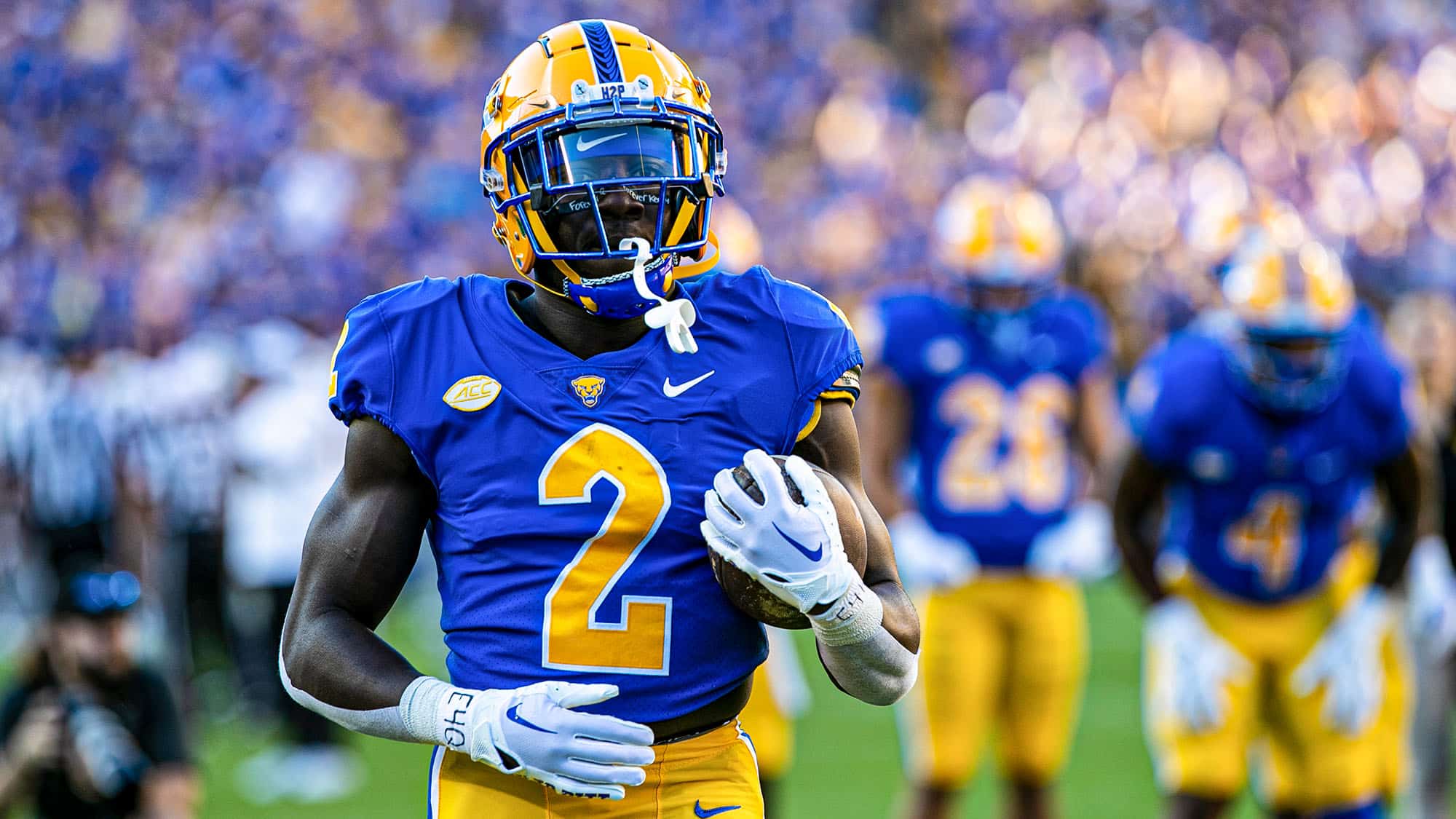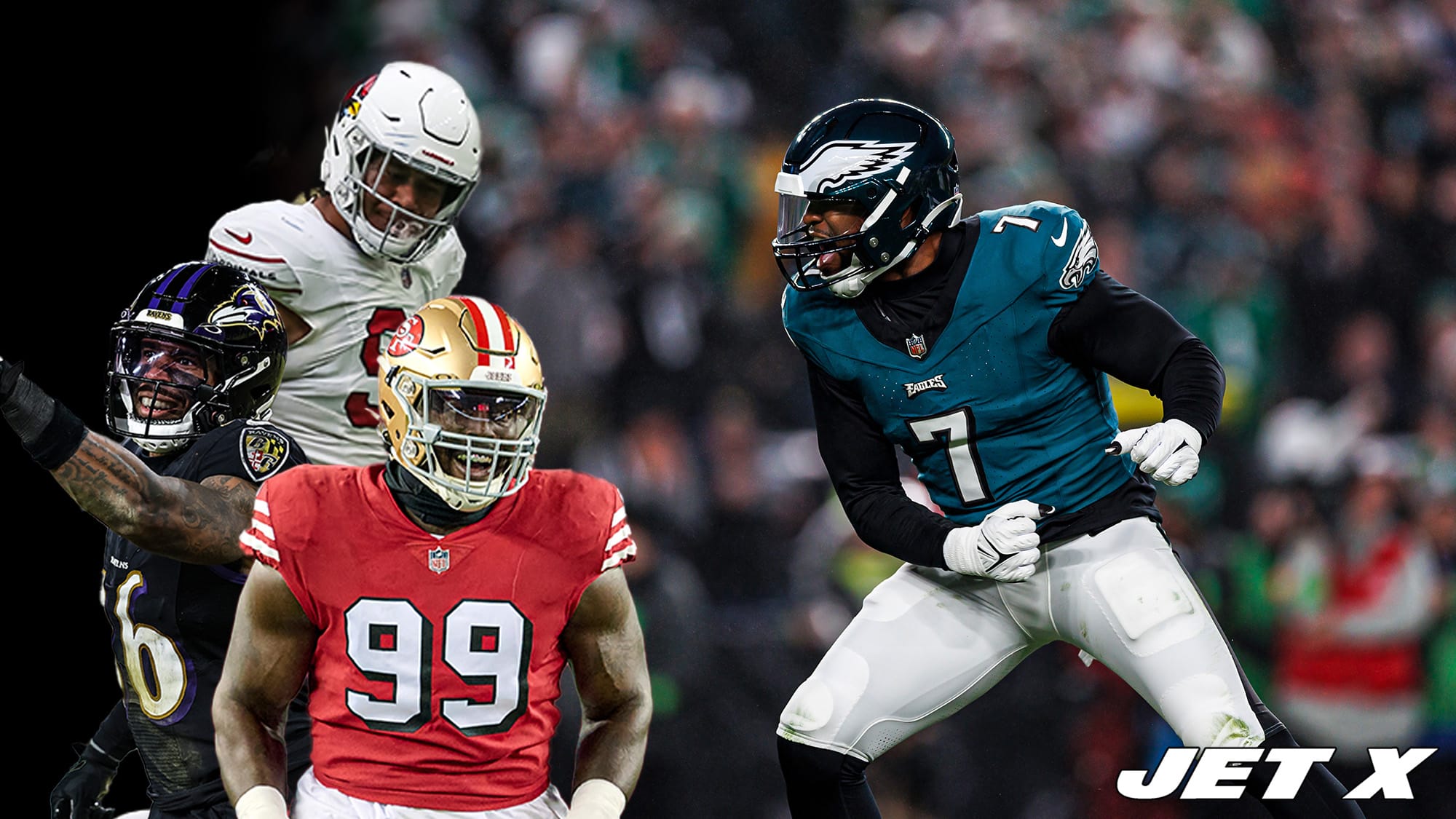Israel Abanikanda needs to clean some things up before he can tap into his exciting ceiling
For the fourth consecutive draft as the New York Jets general manager, Joe Douglas selected a running back. In the fifth round of the 2023 draft, Douglas snagged Pittsburgh’s Israel “Izzy” Abanikanda with the 143rd overall pick.
Abanikanda is coming off an electrifying junior season for the Panthers, rushing for 1,431 yards and 20 touchdowns in 11 games. He is a talented runner who has the traits to develop into another excellent late-round value at the RB position for New York.
However, there are also some major holes in Abanikanda’s game that must be addressed if he hopes to live up to his exciting potential.
To learn everything about Abanikanda as a player, let’s dive into his analytical profile. We’ll touch on all of the strengths that make him an intriguing prospect along with his key areas of weakness.
Jets 2023 draft class analytical profiles:
Measurables/athleticism
Here is a look at Abanikanda’s measurements and drill performances from his pro day, and where they rank all-time among running back prospects:
- Height: 5′ 10¾” (48th percentile)
- Weight: 216 pounds (59th percentile)
- Arm length: 32” (82nd percentile)
- Hand size: 8¼” (2nd percentile)
- Vertical jump: 41″ (96th percentile)
- Broad jump: 128″ (94th percentile)
- 20-yard shuttle: 4.32s (37th percentile)
- 3-cone: 7.14s (36th percentile)
- 40-yard dash: 4.45s (82nd percentile)
- 10-yard split: 1.50s (91st percentile)
Abanikanda is an average-sized running back at 216 pounds and just a shade under 5-foot-11. His arms are long for the position, but his hands are very small.
Athletically, Abanikanda’s best trait is his elite-level explosiveness, as showcased by his top-6% performances in both the vertical jump and the broad jump. You can see this on tape; when Abanikanda sticks his foot in the ground and breaks in a particular direction, his burst is incredible. It’s unique how quickly he accelerates to his top speed off of a break-step.
Abanikanda is patient behind his blockers, and then shows off the burst and speed for the score. pic.twitter.com/16XTm1ewAD
— Nick Penticoff (@NickPenticoff) February 22, 2023
#Jets new RB Israel Abanikanda has an unreal 2nd burst once he passes the LOS. A threat to score any time he touches the rock.
Perfect fit for this offense and outstanding value in the 5th. Plus he allows Breece to ease back in.
Speed. Big plays. Points. pic.twitter.com/R2M3l34Ljj
— Cool Your Jets (@CYJpod) April 29, 2023
Abanikanda’s performance in the explosiveness drills translated to his elite 10-yard split time of 1.50 seconds (91st percentile), which is visualized in the play above. Abanikanda’s 40 time of 4.45 seconds (82nd percentile) ranked a bit lower than his 10-yard split time, suggesting he is more impressive at the start of a breakaway than he is at the tail-end of one. Still, his long speed is very good as well.
Abanikanda did not perform well in the 20-yard shuttle (37th percentile) or the three-cone (36th percentile), suggesting mediocre agility.
Despite his underwhelming times in the agility drills, Abanikanda’s success in other areas was enough to propel him to a Relative Athletic Score of 9.63, ranking third-best among running backs in the 2023 draft class. Only Bijan Robinson (9.85) and Chase Brown (9.81) ranked ahead.
With elite explosiveness, great long speed, and below-average agility, Abanikanda most likely projects as a one-cut runner in the NFL. That would limit him from becoming a workhorse-type back, but it would make him a great fit in the Jets’ outside-zone running scheme as a complementary change-of-pace back.
Greatest strength: Hitting home runs
Matching up with his athletic profile, Abanikanda’s most appealing trait at Pittsburgh was his home-run-hitting ability.
Abanikanda accumulated 631 “breakaway” yards in 2022 – i.e. yards that were gained on rushes of 15+ yards. Coming over 11 games, this gave Abanikanda an average of 57.4 breakaway yards per game, which ranked fourth-best among FBS running backs (min. 10 GP). It ranked second-best among Power-5 running backs, trailing only Seattle Seahawks second-round pick Zach Charbonnet of UCLA (60.6 YPG).
It’s not as if Abanikanda merely profited off 15-to-20 yard gains to rack up his breakaway production. When he broke loose, he usually won the footrace and turned a great gain into a game-altering one.
Abanikanda’s 631 breakaway yards came on just 19 breakaway runs (gains of at least 15 yards). That gives Abanikanda an average of 33.2 yards per breakaway run, which ranked fifth-best out of the 41 FBS running backs with at least 15 breakaway runs. It’s nearly seven yards above the national average for running backs, which was 26.6.
Jets fans, this is what happens when you give Izzy Abanikanda (@IAbanikanda) a seam pic.twitter.com/b1Y3Lb0v6R
— The Loyal Sons (@TheLoyalSons) April 29, 2023
The key issue: Has a lot of work to do in the passing game
Most likely, the main reason NFL teams passed on Abanikanda until the fifth round is his sketchy resume in the passing game. Abanikanda requires substantial improvement in most passing-game facets.
The biggest issue is Abanikanda’s pass-blocking. In 2022, Abanikanda allowed 9 total pressures on 61 pass-blocking snaps. His allowed pressure rate of 14.8% ranked 182nd out of 199 qualified FBS running backs. For perspective, the FBS average for running backs was 8.8%.
Drops are another problem. Abanikanda’s career drop rate at Pittsburgh was 11.6% as he dropped five passes on only 38 receptions. That is much higher than the 2022 FBS average for running backs (7.5%). In 2022, Abanikanda had a brutal drop rate of 14.3% as he dropped two passes despite making just 12 receptions.
Abanikanda also didn’t record much production as a receiver. He never had a season with more than one receiving touchdown or more than 197 receiving yards. This past season, despite blossoming into Pittsburgh’s workhorse runner, Abanikanda saw his reception total decline to 12 after catching 24 passes in 2021.
On the positive side, Abanikanda made the most of his chances to make plays as a dump-off option. He averaged 9.1 yards after the catch per reception in his career (2022 FBS RB average: 8.6). Most notably, Abanikanda showed impressive elusiveness as he forced 17 missed tackles on 38 receptions, an average of 0.447 per reception (2022 FBS average: 0.255).
In both of those aforementioned areas, Abanikanda was especially dynamic during his final season. It was a small sample, but on 12 receptions, Abanikanda averaged 12.7 YAC per reception (152 YAC) and 0.750 missed tackles forced per reception (9 MTF). Among the 190 RBs with at least 10 receptions, Abanikanda ranked 10th-best in YAC per reception and second-best in MTF per reception. Again, that’s a tiny sample, but it’s good to see a positive trait to balance out his many weaknesses.
While Abanikanda has flashed exciting efficiency as a safety-blanket receiver in the underneath area, the reason for Abanikanda’s modest overall receiving production is his inability to do anything other than catch passes underneath. Abanikanda never caught a pass that was thrown over 10 yards downfield. He was targeted twice and both passes fell incomplete.
Most of Abanikanda’s career receptions barely went beyond the line of scrimmage. Of Abanikanda’s 354 career receiving yards, 344 of them came after the catch. Abanikanda gained only 10 air yards in his entire career. That’s not particularly unusual for a college running back – in fact, FBS running backs collectively averaged -0.5 air yards per reception in 2022 – but for a running back going to the NFL, it puts him a step behind other prospects who have showcased more versatility as receivers.
Perhaps Abanikanda is capable of doing more as a receiver and just didn’t get the chance to show it in Pittsburgh’s offense. If that’s true, we’ll have to see it before we can believe it. He’ll need to show softer hands before he can be trusted to handle more opportunities, and before he can even get himself on the field for more passing plays, he has to become a better pass-blocker.
Another notable red flag for Abanikanda is the three fumbles he had in 2022 (all were as a rusher).
Usage/scheme
When it comes to Abanikanda’s usage in Pittsburgh’s offense, he was deployed in a very traditional fashion. Abanikanda lined up in the backfield on 94.4% of his snaps in 2022. He had 10 slot snaps and 6 snaps out wide. Pittsburgh also used him in the wildcat on 6 snaps.
Schematically, Abanikanda is ready to transition into the Jets’ outside-zone running game. According to PFF, 68.8% of Abanikanda’s career carries at Pittsburgh came on zone-running concepts.
The Virginia Tech game
Abanikanda attracted national attention in 2022 for a video-game-like performance against Virginia Tech where he ran for 322 yards and six touchdowns. While it was a mesmerizing performance that showed everything there is to love about Abanikanda as a prospect, it’s somewhat concerning how drastically this one game boosted his season-long numbers.
Abanikanda gained 237 of his 631 breakaway yards (38%) and seven of his 19 breakaway runs (37%) in the Virginia Tech game. He did not have more than two breakaway runs in any other game.
Keep in mind that Virginia Tech was a 3-8 team that went 1-6 in the ACC (only beating 3-9 Boston College) and 1-5 on the road. Sure, it might seem like nitpicking to poke holes in a 322-yard/6-touchdown game. But it’s definitely worth noting that Abanikanda amassed such a colossal portion of his season-long production in one home game against a bad team.
Kick returns
Abanikanda never returned a punt at Pittsburgh, but he did return 19 kickoffs, generating mixed results. While Abanikanda scored a 98-yard return touchdown in 2022, his other 18 career returns only averaged 18.7 yards with a long of 24 yards.
Abanikanda is an instant home-run threat with plenty of work to do in other areas
For Abanikanda to become anything more than a complementary running back and special teamer, he will have to make significant progress in a multitude of areas, including pass-blocking, drops, ball security, and receiving versatility.
Fortunately for the Brooklyn native, the hometown Jets are a perfect landing spot for him to ease into the NFL. New York’s outside-zone scheme emphasizes the positive aspects of Abanikanda’s game and should allow him to start his career by focusing on doing what he does best.
As a change-of-pace backup who handles a low volume of carries and always comes in with fresh legs, Abanikanda’s acceleration, burst, long speed, and one-cut running style will play well in the Jets’ offense. I’d expect him to be a high-YPC runner with a boom-or-bust distribution of outcomes, picking up a high percentage of stuffed runs but making up for it with a high percentage of breakaway runs.
Because of his weaknesses, I don’t believe Abanikanda is ready to fill in as a starter in case of injury to players above him on the Jets’ depth chart. Michael Carter (even with his 2022 struggles) and Zonovan Knight are probably better suited to fill in for Breece Hall than Abanikanda at this stage – barring tremendous progress from Abanikanda this offseason.












The weaknesses listed here are major concerns. Maybe the pass blocking can be improved, but with his small hands, it doesn’t seem like he will ever be a good receiver and fumbles are a total no no. Just one or two fumbles and this guy will be banished to the end of the bench for weeks. Sounds like a very limited player, maybe even a waste of a draft pick.
He will be the 2nd best RB from on the roster from day one. Note, I said RB and will get more carries than MC or Knight. MC and Knight are below average and definitely cannot be trusted if Breece is not ready.
In his rookie year Carter was impressive in his yards after initial contact.
Having him as rb3 and Bam at 4 is an impressive backfield